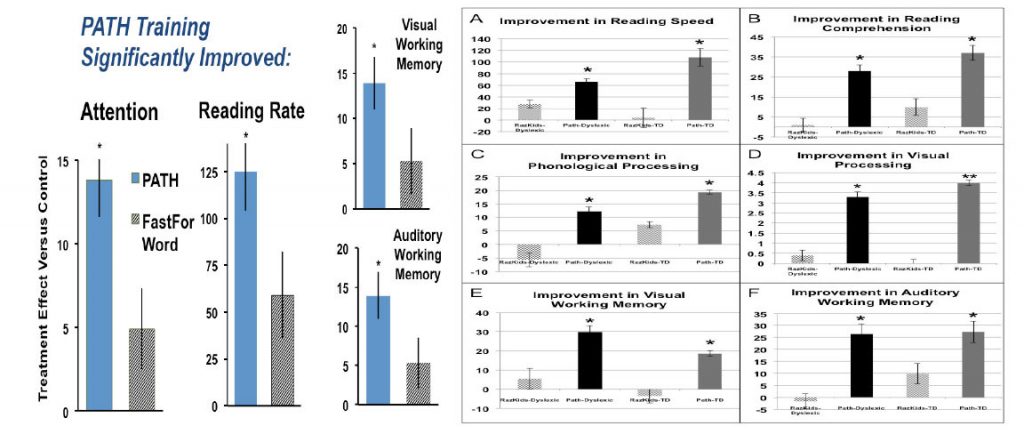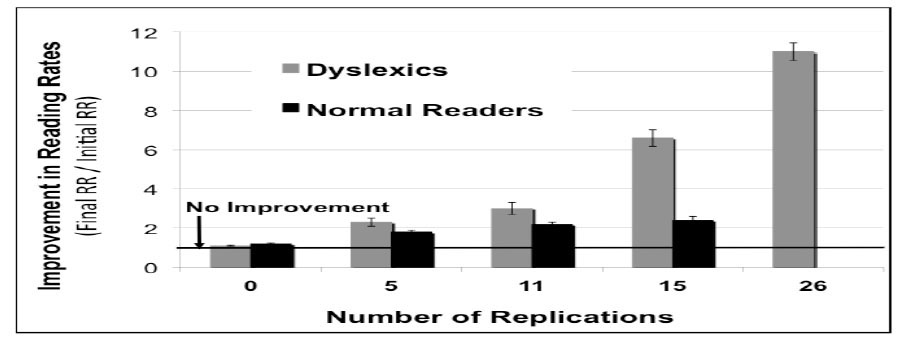Why Every Child Benefits from Being Trained on PATH To Reading (PATH):
PATH prevents reading and learning problems, eliminating the need for Special Needs classes.
Learning problems are caused when a child’s brain is not working as efficiently as it could be.
Groundbreaking training on PATH To Reading can change this rapidly and effectively!
What is the underlying problem?
The common underlying problem is that the motion and pattern pathways of the brain are not working together. The timing of cells in the motion pathways are 1/10 of a second too slow. When reading, the motion cells signal the location, and overall shape and form of a word to gate the information going to the patterns cells. This is used as a starting point for deciphering the individual letters. The visual system uses this dichotomy between a fast motion channel and a slower pattern channel for the purpose of selective attention, reading, and remembering.
What makes a good reader?
Good readers don’t have to think about reading. Their auditory and visual processing skills work in synchrony and without much effort. These foundational cognitive skills come naturally for good readers and need to be developed for others.
How does PATH training prevent reading and learning problems?
PATH training improves the timing and sensitivity of motion discrimination in the brain, so that the motion and pattern pathways work together effectively while reading. Data proves that reading speed, attention, and working memory improve significantly when PATH motion training precedes guided reading in the classroom.
PATH beats FastForWord (FFW) with half the training time: Improvements of Treatment effect over Controls (Learning Upgrade) in reading (*significant at p=0.004), attention (*p=0.007), phonological processing (*p=0.001), and auditory working memory (*p=0.03) following PATH compared to FFW training. Only PATH significantly improved reading speed and attention in struggling readers.
PATH is the only intervention that: 1) changes the visual timing in the brain, and 2) improves academic skills regardless of reading level, when followed by reading aloud, in both typically developing (TD) as well as Special Needs students, such as ADHD, autism. In controlled validation studies, PATH has been found to improve reading speeds from 2-11 fold, as shown below and above, as well as attention, and auditory working memory. The more training on PATH, the more reading speeds improved when followed by guided reading. PATH training has proven to be much faster than other interventions and can be administered to an entire class of students in the computer lab or classroom, unlike most other reading interventions.
The more training on PATH, the more reading speeds improved when followed by guided reading for TD and struggling readers.
Testimonials from those using PATH to strengthen the underlying skills that enable more efficient learning:
“I wanted to share my appreciation for PATH to Reading and my gratitude for your contribution to my students’ success. We initially implemented the PATH to Reading as a part of our RTI program and found incredible success. Many students who had received numerous interventions with limited reward found almost immediate and substantial success with PATH to Reading. After about 6-8 weeks, most of the students had gained substantially, many of who reach grade level equivalency during that period of time. We didn’t stop there, though. We had many students who were working successfully at grade level, but we saw them working too hard and figured they had greater potential, so we had them do PATH to Reading as well. The results were astonishing. These students’ academic performances, and subsequent confidence and excitement about learning, skyrocketed. As Chief Academic Officer of a school dedicated to the premise of creating gifted learners, we found PATH to Reading an invaluable tool.”
Dr. Cy Cole, Great Valley Academy, Modesto, California
“I saw a 3rd grader that was reading at a 4th grade level who was brought to me because his eyes would tire after just a little reading time. He was a Convergence Insufficiency (CI) kid so I put him in PATH for about 3 months. He now has no CI and is reading at an 11th grade level. So, I am convinced it is one of the greatest tools in education.”
Dr. Eldon Rosenow, Director of Great Valley Academy, Modesto, California
“For the last four years, some of my second grade students have participated in the PATH to Reading program. I was able to observe that they improved their attention span, were able to pay more attention to class instructions, and did a better job at following and doing classroom assignments. For instance, there were cases in which students had been showing signs of dyslexia, changing the order of numbers and letters. As a result of their participation in the PATH to Reading program, these students began to write with less mistakes and more efficiency. I also noticed that they were able to follow instructions more easily and were less prone to distraction than before. The level of concentration and understanding of concepts also improved and they were much more likely to finish their class assignments on time. In the case of ADHD students, it was clear that they were less distracted by peer interactions, they were able to focus more, and produce better work. Reading comprehension also went up, and they were more comfortable writing their own ideas on paper. I was always eager to have my students selected to participate in the program. All the students involved really benefited from this program. I was very pleased to see that the PATH program had such positive results.”
Ximena Vidales-Zamosc, Second Grade Teacher, Walker Elementary, San Diego Unified School District
“After only 1-2 months working with Dr. Lawton, a remarkable difference was noticed in Kyle’s ability to read. With PATH
therapy, Kyle has not only improved his spelling and writing skills, but we also have seen a dramatic improvement in his willingness to pick up a book, and understand what he has read.”
Kerrie Vargas, Oak View, California
“I first became aware of Dr. Lawton’s unique and valuable research program in 2007 and since that time I have begun an independent investigation of the efficacy of the PATH treatment in shifting reading ability and Visual Evoked Potential (VEP) responses in college students with reading difficulties. We found that after a short amount of training, the abnormal VEP of dyslexics now had normal VEPS, as reported at the 2010 annual meeting of the College of Developmental Optometrists. Dr. Lawton has specified not only the mechanism of disordered processing in dyslexia, a putative magnocellular (motion) deficit, but also the location of the deficit in a specific area in the brain, the motion area: Medial Temporal (MT) cortex, and its inputs to this area. What makes her product so valuable is that she is offering, to my knowledge, the only treatment which directly addresses disordered magnocellular (motion) / parvocellular (pattern) interactions. I am excited to be involved in this pioneering research, and firmly believe that this product has the potential to help a large number of reading disabled individuals, as well as normal readers, to read more fluently.”
Professor John Shelley-Tremblay, Department of Psychology, University of South Alabama, Mobile, AL.
For more information or to arrange a meeting please contact Perception Dynamics Institute 310-903-6009 or info@pathtoreading.com


